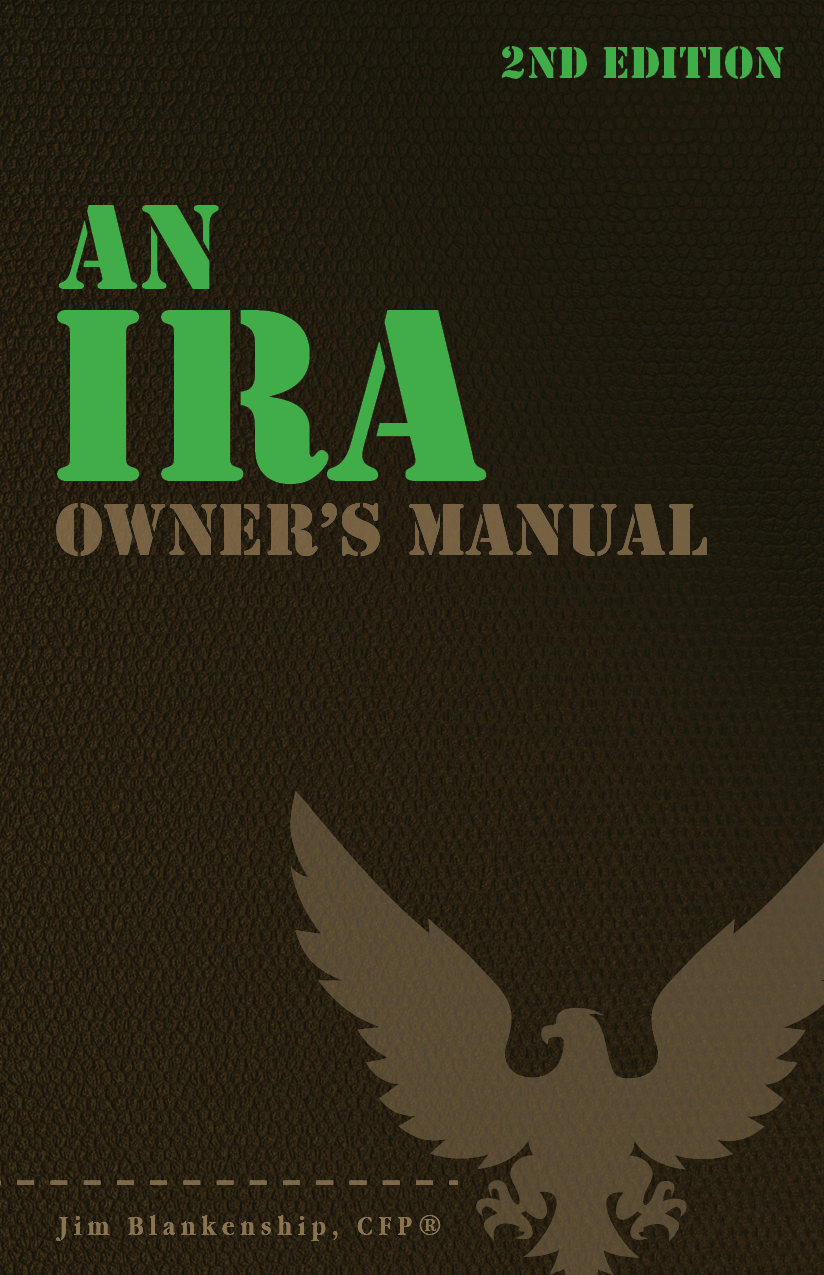This November we’re encouraging folks to increase their retirement savings rate by at least 1% more than the current rate. It’s a small step, but it will pay off for you in the long run. Below is the list of my fellow bloggers who have written articles showing ways that you can start to increase your savings rate, as well as showing what the benefits can be. Thanks to everyone who has participated so far – and watch for more articles in the weeks to come! THE 1% MORE BLOGGING PROJECT by Robert Flach, @rdftaxpro A Simple Strategy to Maximize Open Enrollment by Jacob Kuebler, @Jakekuebler Take a Small Step: Increase Your Savings by 1% by Jim Blankenship, @BlankenshipFP
IRA
The Other Life Insurance – Annuities
The last few weeks I have been writing about the more conventional form of life insurance that most people are familiar with when I say ‘life insurance’ – which is protection against a premature death. The other life insurance is that which protects your from living too long – and that insurance is the annuity. Over the years annuities have gotten a bad rap – and rightfully so. Like life insurance, annuities are generally sold to the public via a sales force of licensed agents. In most cases, they are not the right vehicle for the individual (I know I am setting the blog up to receive the thunderous rebuttals) but there may be cases where an annuity makes sense. The other reason annuities get a bad rap is because of the pure insurance (longevity) feature that they provide – especially pure life annuities. A pure life annuity is simply […]
Retirement Plan Contribution Limits for 2014
The IRS recently published the new contribution limits for various retirement plans for 2014. These limits are indexed to inflation, and as such sometimes they do not increase much year over year, and sometimes they don’t increase at all. This year we saw virtually no increases for most all contribution amounts, but as usual the income limits increased for most types of account. IRAs The annual contribution limit for IRAs (both traditional and Roth) remains at $5,500 for 2014. The “catch up” contribution amount, for folks age 50 or over, also remains at $1,000. The income limits for traditional (deductible) IRAs increased slightly from last year: for singles covered by a retirement plan, your Adjusted Gross Income (AGI) must be less than $60,000 for a full deduction; phased deduction is allowed up to an AGI of $70,000. This is an increase of $1,000 over the limits for last year. For […]
Call All Bloggers! 2nd Annual 1% More Blogging Project
I’m sure that I’m not alone in the financial planning world with my concern about the rate of saving toward retirement across this great land. Recent figures have shown that we Americans are not doing as this year as last, at a 4.6% rate versus 5% last year when we started this project. This is a dismal figure when you consider how most folks are coming up way short when they want to retire. Just like last year in November, I thought maybe something could be done to encourage an increase in savings – if only by 1%, this can be a significant step for lots of folks. November is the perfect time to do this, as most corporations are going through the annual benefit election cycle, so the 401(k) (or 403(b), 457, or other savings plan) is right at the forefront for many folks. I’m proposing that all financially-oriented […]
Take a Small Step: Increase Your Savings by 1%
As savers, we Americans are not doing a good job. We’re improving (according to recent data), but still way behind what we should be saving. But it doesn’t have to be that way – you can take small steps to increase your savings right away, and it doesn’t have to hurt. The Bureau of Economic Analysis recently reported that we are saving at a rate of around 4.6% of disposable personal income, an increase of 0.1% over the prior month. On a per-person basis, that works out to about $1,831 saved per month, or just short of $22,000 per year. Since we know that very, very few people are exactly average (by definition most people are going to be something above or below the average), what concerns me is that even those who are a bit above the average are still not saving enough. And woe to those who are […]
NUA Allocation Twist – Not as Easy as it Looks
I’ve written much about the Net Unrealized Appreciation (NUA) treatment for company stock in a 401(k) plan – this is the provision that allows you to pull out company stock as part of a full distribution from the plan and get favorable tax treatment for the gain on the stock. More about NUA can be found in this article about Net Unrealized Appreciation Treatment. One of the factors in that article speaks to a special way to allocate the basis (original cost) of the stock. Specifically, if handled correctly, the ordinary income tax on the NUA move can be minimized or eliminated, and the capital gains treatment maximized. However. (As you know, there’s always a however in life!) The problem with this move is that you absolutely must get the 401(k) administrator to go along with your plan – in order to make sure that the 1099R generated by your […]
How the 3.8% Surtax Could Influence Roth Conversions
Note: This is a dust-off of an article written in April 2010 that dealt with the special two-year taxation of Roth Conversions that was available in that year. An astute reader noted that the original was a bit dusty and not applicable to today’s decision-making (thanks S!). One of the provisions of the Affordable Care Act is a new tax – a surtax on investment income over certain amounts. This surtax has come into play this year, for tax returns filed in 2014 on 2013 income. The income amounts are, admittedly, rather high, but nonetheless will likely impact a lot of folks. What you may not realize is that, due to the application of this surtax, Roth IRA conversion strategies that you may have had in play may be impacted. Depending upon your overall income, you may have to pay the surtax on some or all of your conversion amount. […]
When Rolling Over a 401(k) to an IRA Isn’t a No-Brainer
Oftentimes when folks are considering leaving employment, the decision to rollover 401(k) to an IRA is a no-brainer. After all, why would you leave your retirement funds at the mercy of the constricted, expensive investment choices and other restrictions of your old company’s 401(k) administrator, when you can be free to invest in any (well, most any) investment you choose, keeping costs down, and completely within your own control in an IRA? Well, for some folks this decision isn’t the straightforward choice that it seems to be, for the very important reason of access to the funds before reaching age 59½ (see this article for more info about The Post-55 Exception to the 10% Penalty for Withdrawals from 401(k)). Since only within a 401(k) (or other employer-sponsored plans) can you take advantage of this early withdrawal exception, it might be in your best interests to think about your rollover choice […]
5 Essential Financial Planning Steps for Your 30s and 40s
(jb note: the article below is from my friend Roger Wohlner, who blogs at The Chicago Financial Planner.) Many of the calls that I receive are from folks in their 50s or 60s who are either within sight of retirement or already retired. Many of these callers are pretty well-prepared for retirement and are seeking my help to fine-tune their situation and/or to help them through this next phase of life. This type of financial readiness doesn’t just happen it takes planning and preparation. Here are 5 essential financial planning steps for those of you in your 30s and 40s to help you reach your retirement goals and more importantly to help you achieve financial independence. Get started If for whatever reason you haven’t done much of anything to ensure your financial future it’s time to get going. Today is the best day to get started, tomorrow is the second best […]
Book Review: A Random Walk Down Wall Street
Right from the start this book will be an excellent read for both financial advisors as well as their clients. Dr. Malkiel provides academic insight on the reasons why passive management works and some great commentary on the use of index funds as part of someone’s overall portfolio. This was the second time I read this book and certainly not the last. It’s great reinforcement on why we invest our clients’ money the way we do and provides solid academic evidence that doing anything to the contrary is counterproductive, more expensive and simply playing a loser’s game. Some of the bigger takeaways from the book are Dr. Malkiel’s thoughts and research on the different part of the Efficient Market Hypothesis or EMH. The EMH consists of three parts – the strong form, the semi-strong form and the weak form. The EMH essential admits that markets are efficient – meaning that current […]
Stretching an IRA When There Are Non-Individual Beneficiaries
As we’ve discussed here previously, one of the requirements to enable an inherited IRA to be “stretched” over the lives of the beneficiaries is that all of the beneficiaries must be individuals. That is to say, none of the beneficiaries can be something other than a person, such as a trust (specifically a trust that is not a see-through trust), a charity, or an estate. If even one beneficiary is not a person, then all of the beneficiaries must take distribution within five years. But there’s a way around this, and it has to do with the timing of distributions. When an IRA owner dies, there is a key date to know: September 30 of the year following the year of death of the owner. On that date, the beneficiaries are “set” for the IRA, and if available, the Designated Beneficiary is named. It is on this date that the […]
When is a RMD a RMD?
I receive quite a few questions from folks looking for clarification on the rules around Required Minimum Distributions upon reaching age 70½, so I thought I’d jot down a couple of facts about them that you may find interesting. When can I take the distribution? Looking through some notes from readers I found one where it was asked (this is paraphrased for clarity): My birthdate is April 10, 1943, so I will reach age 70½ on October 10, 2013. Do I need to wait until October 10 or after to take a distribution so that it is counted as my RMD? I responded to this question by saying that, to be safe, I suggest the reader wait until after October 10 to take the distribution. However. (there’s always a however in life, isn’t there?) I subsequently received a message from a reader (thanks, TAM!) with the following updated information: It […]
The Qualified Terminable Interest Property (QTIP) Trust
Often we come up against situations in planning finances for folks where some special tools are necessary. One of those situations, quite common these days, is when one or both members of a couple has children by a prior marriage. The situation brings about some interesting questions when considering how the marital assets will be divided when one member of the couple has passed on. Daryl has three children by a prior marriage, and his wife Toni also has three children by a prior marriage. Both Daryl and Toni have considerable assets from before their marriage – each has a investments and retirement accounts in their own name: Toni’s accounts are worth $350,000, and Daryl’s accounts are worth $300,000. Given their lifestyle, they will not be needing much of their accounts early in retirement – but it’s quite likely that later in life they may need the accounts for medical […]
Book Review: How to Retire Happy
“The 12 most important decisions you must make before you retire” Author Stan Hinden, who is the former syndicated Washington Post “Retirement Journal” columnist, has just released his Fourth Edition of this book. The book is Hinden’s commentary and advice, as well as a sort of journal, as he and his wife Sara entered into and have been living in retirement over the past 17 years. Hinden retired in 1996 at the age of 69, at which time he began writing the “Retirement Journal” column. He was nominated for a Pulitzer Prize in Commentary in 1998 for his work. This book is an excellent read for folks who are planning toward retirement or have recently retired. Hinden has organized the process into 12 decisions, some of which include: “Am I Ready to Retire?”, “What Should I Do with the Money in My Company Savings Plan?”, and “Where Do I Want […]
Exceptions to the 10% Early Withdrawal Penalty from IRAs and 401(k)s
When you take money out of your IRA or 401(k) plan (or other qualified retirement plan, such as a 403(b) plan), if you’re under age 59½ in most cases your withdrawal will be subject to a penalty of 10%, in addition to any taxes owed on the distribution. There are many exceptions to this rule though, and the exceptions are not the same for all types of plans. IRAs have one set of rules, and 401(k)s have another set of rules. The exceptions are always related to the purpose for which the money was withdrawn. The exact same dollars withdrawn do not have to be used for the excepted purpose, just that the excepted expense was incurred. IRA Exceptions It is important to know that all distributions from your traditional IRA are subject to ordinary income tax, but some distributions are not subject to the early withdrawal penalty. The list […]
Avoid Awkwardness in the Afterlife–Confirm Your Beneficiary Designations
This is a topic that I cover with all clients, and one that I recommend you for everyone with retirement plans and other accounts with beneficiary designations. Too often we think we have the beneficiary designation form filled out just the way we want it, and then (once it’s too late) it is discovered that the form hadn’t been updated recently – and the designation is not what we hoped for. I made this recommendation to a client not long ago. He assured me that he had all of his designations set up just the way he wanted. His wife, sitting next to him in our meeting, asked him to make sure – talk to the IRA custodian and get a copy of the designation as it stands today. A bit miffed about it all, he agreed to do so, and did the next day. Guess what he found – […]
State Income Tax and Retirement Income
On only a few rare occasions does it make sense to defer money to your 401(k) or other employer sponsored plan instead of a Roth IRA. Those occasions include when your gross income excludes you from contributing directly to a Roth IRA (you can still convert), you are currently at a very high tax rate or the case of when you live in a state where retirement income is excluded from state taxation. Here in Illinois, the current law exempts retirement income from being taxed at the state level. What this means, is that any contributions to a 401(k), 403(b), SEP, SIMPLE and 457 avoid state income taxation. Qualified distributions at retirement are only taxed at the federal level, and then only as income. If you contribute directly to a Roth IRA that money is after-tax money going in. After-tax in this case meaning it’s been already taxed at the […]
Fixing an IRA With the “Wrong” Beneficiary
Quite often, for many different reasons (often known only to the deceased original owner), the original owner of an IRA designates a beneficiary that the survivors don’t necessarily agree with. It might be that only one of several children is designated, or perhaps additional beneficiaries are designated along with a spouse. In cases like these, there are ways to make changes to the outcome of the inheritance. In this article we specifically deal with the case where only one of four children was designated as the primary beneficiary of the IRA. To resolve the situation, let’s consider the following IRA: John, the decedent, designated April (his daughter) as the primary beneficiary of his IRA. It isn’t known why John only designated April as the beneficiary, as he has three other children – Bill, Chuck, and Dale – and John had only his IRA as an asset to pass along to […]
Last-Minute Tax Tips
Since today is D-Day for income tax filing, I’ve pulled together a few recent tips that the IRS published. These tips cover a few of the areas that you may find interesting, including how to get a six-month extension for your filing (but not for payment of tax), errors to avoid as you complete your tax return, how to make IRA contributions, and tips for the self-employed at tax time. This is a much longer post than I normally write, but I think it has a lot of very good and very timely information that will be useful today. The actual text of these tips are listed below, with the reference number of each tip. IRS Newswire IR-2013-38 Can’t File by April 15? Use Free File to Get a Six-Month Extension; E-Pay and Payment Agreement Options Available to People Who Owe Tax WASHINGTON – The Internal Revenue Service today […]
A Few Facts to Know About Retirement Plan Contributions
As we near the tax filing deadline, there are a few things you need to be aware of as you consider your retirement plan contributions for tax year 2012 (or whatever the prior tax year is, if you’re reading this sometime later). Regular IRA contributions are due by the filing deadline, with no extensions. That means April 15, 2013 for the 2012 tax year. Your contribution for 2012 is considered made “on time” if your payment is postmarked by midnight on April 15, 2013. Perhaps you wish to make a more substantial contribution to a retirement plan – in 2012, you can contribute up to $50,000 to a Keogh plan. That amount is limited to 20% of the net self-employment income, or 25% of wage income if the individual is an employee of the business. Keogh plan contributions can be made by the extended due date of your return – […]


 Sterling Raskie, MSFS, CFP®, ChFC®
Sterling Raskie, MSFS, CFP®, ChFC® The latest in our Owner’s Manual series, A 401(k) Owner’s Manual, was published in January 2020 and is available on
The latest in our Owner’s Manual series, A 401(k) Owner’s Manual, was published in January 2020 and is available on  A Medicare Owner’s Manual, is updated with 2020 facts and figures. This manual is available on
A Medicare Owner’s Manual, is updated with 2020 facts and figures. This manual is available on  Social Security for the Suddenly Single can be found on Amazon at
Social Security for the Suddenly Single can be found on Amazon at  Sterling’s first book, Lose Weight Save Money, can be
Sterling’s first book, Lose Weight Save Money, can be  An IRA Owner’s Manual, 2nd Edition is available for purchase on Amazon. Click the link to choose the
An IRA Owner’s Manual, 2nd Edition is available for purchase on Amazon. Click the link to choose the  Jim’s book – A Social Security Owner’s Manual, is now available on Amazon. Click this link for the
Jim’s book – A Social Security Owner’s Manual, is now available on Amazon. Click this link for the  And if you’ve come here to learn about queuing waterfowl, I apologize for the confusion. You may want to discuss your question with Lester, my loyal watchduck and self-proclaimed “advisor’s advisor”.
And if you’ve come here to learn about queuing waterfowl, I apologize for the confusion. You may want to discuss your question with Lester, my loyal watchduck and self-proclaimed “advisor’s advisor”.